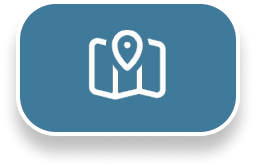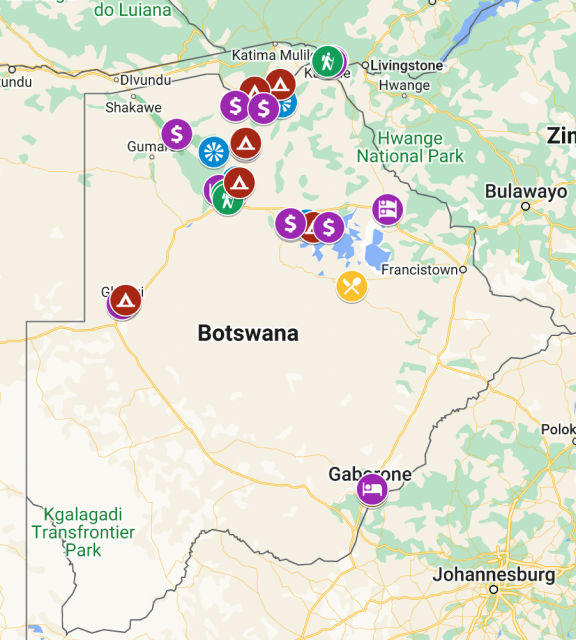The ultimate Road Trip: 2 to 5 weeks self-drive itinerary for South Africa (no 4x4 needed!)

Content
Key information at a glance
| Price for rental: | 30 - 60 EUR / day, depending on car type and time of year |
| Itinerary lenghth: | 2 to 5 weeks |
| Documents needed: | International drivers’ license |
| Best time to travel: | depending on region, for the whole tour May to October is best |
| For you if: | You love adventure, nature, and are a seasoned driver |
| Not for you if: | you are uncomfortable driving on non-tarred roads; long times spent in a car isn't your thing |
| Country Overview: | Head here for a general overview over South Africa |
Before my husband and I went on our self-drive adventure of Southern Africa (across South Africa, Botswana and Namibia), I spent countless hours researching where to sleep, eat, and what to visit — but it was all worth it. This journey became one of my all-time favorites, and I hope this detailed guide for the South Africa Part helps you plan your own unforgettable adventure.
For a full overview of our favourite restaurants, vineyards, hotels and hidden spots along this route, check our Travel Guide!

Do I Need a 4x4 for a South Africa Road Trip?
The short answer is no, you don't necessarily need a 4x4 vehicle for a road trip through South Africa.
But let's dive deeper. Before embarking on our journey, I (Laura) spent quite a while debating whether to rent a 4x4 or stick with a standard vehicle. Many travel blogs suggested opting for a 4x4 to avoid limiting your route options. However, especially for longer trips (think three weeks or more), the cost difference between a 4x4 and a regular SUV can be quite significant.
Being someone who hates compromising on destinations — I want to see it all, including off-the-beaten-path spots — I listed all the places we wanted to visit and researched whether a 4x4 was truly necessary for each. Surprisingly, we found that you do not need a 4x4 for most of the destinations on our South African itinerary.
Some remote areas or rugged terrains might be challenging without a 4x4. For example, certain parts of the Drakensberg Mountains or specific trails in the Cederberg region may be more accessible with a higher-clearance vehicle. But with careful planning and by sticking to well-maintained roads, you can still reach all places mentioned in the itinerary.
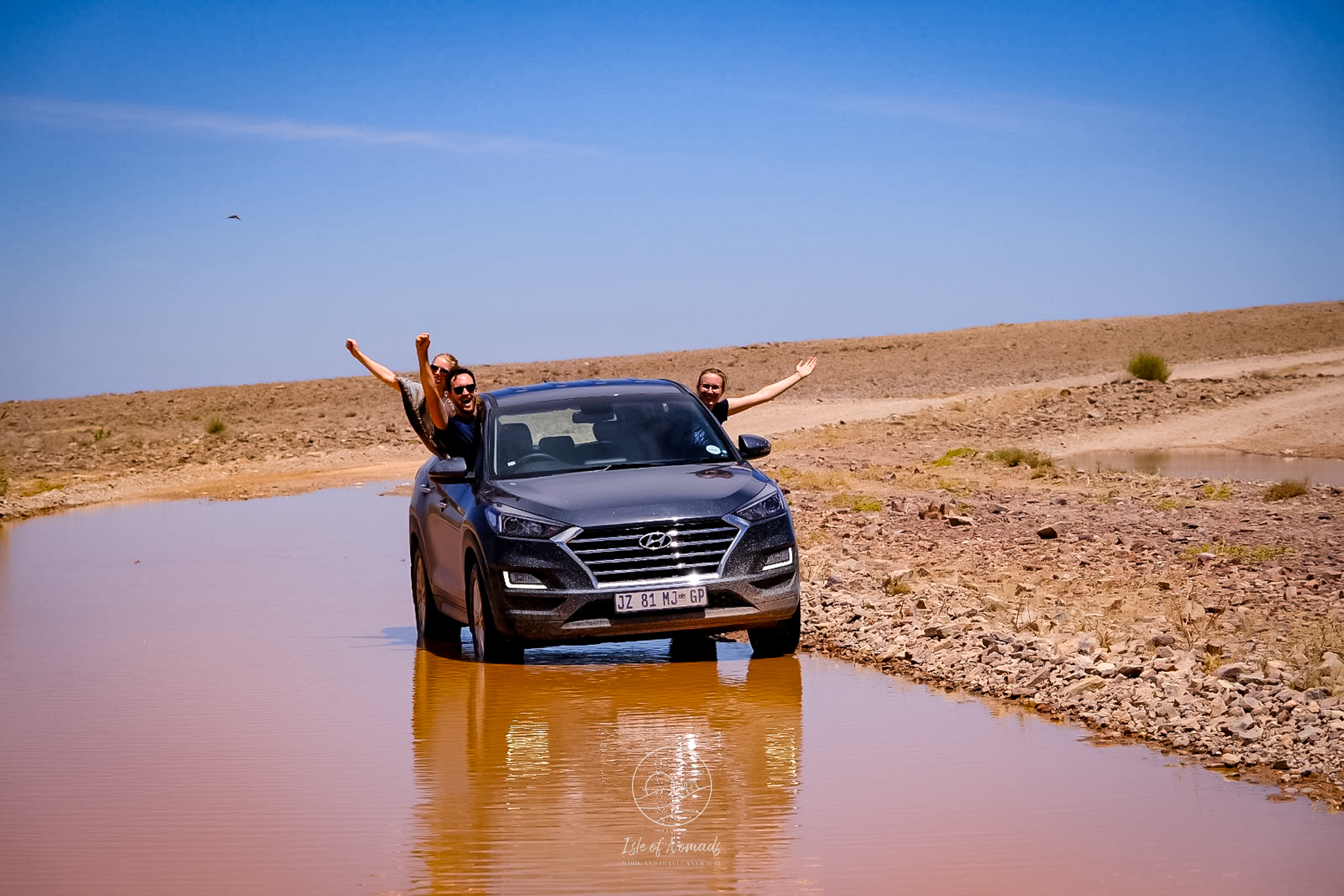
Where to Rent Your Car
If budget isn't a concern, you should rent from a well-established company like Avis or Europcar. These larger rental agencies have a good presence throughout South Africa and can offer quicker assistance or vehicle replacements if that is needed. If you'd like to go with them, I'd recommend you use Kayak or Booking.com to find good deals on the car.
We chose to rent our car through Around About Cars, and our experience was mixed. While everything turned out fine in the end, we encountered some stress upon arrival. When we landed at the airport around 11 PM, the office of their partner agency, Tempest, was already closed. We had to turn to Avis for help. Unfortunately, we discovered that Around About Cars hadn't forwarded our information, so we had to fill out all the paperwork again. Moreover, the car class we initially booked and paid for was incorrect, and the vehicle they offered was far too small for four people and their luggage (we were traveling with friends).
Eventually, they resolved the issue, but it required us to extend our stay in Cape Town to sort everything out. Despite this rocky start, we didn't face any more problems during our two-month rental period. We swapped our car for a new one after 30 days in Durban, and the local Avis branch provided exceptional service. Also I have to mention that this was the only time we had problems with Around About Cars - we also went with them for our stays in 2024 and 2023 and never had another issue.
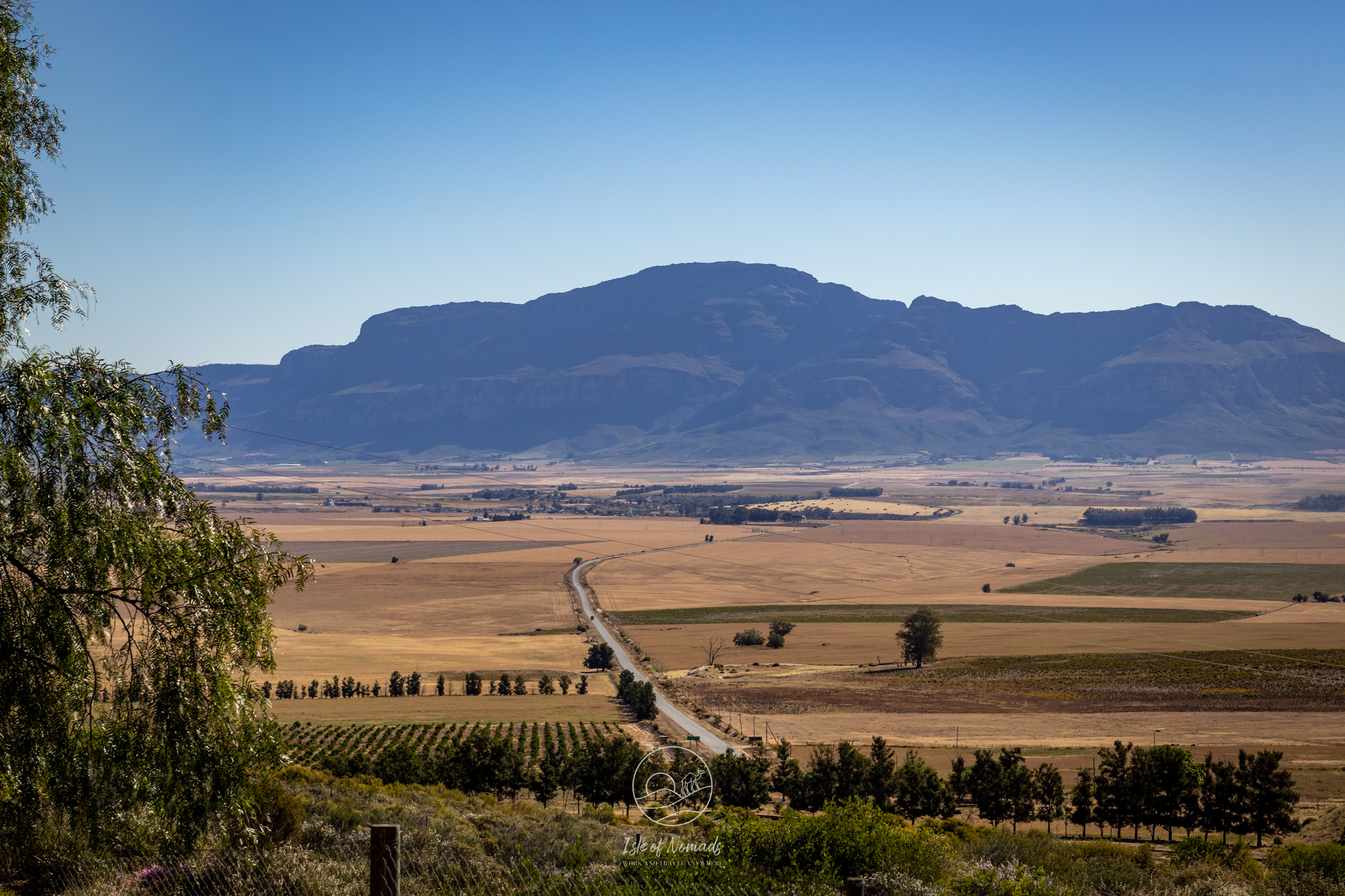
Is it safe to drive through South Africa?
Often, travellers are concerend about safety in South Africa, especially if you are driving in your own vehicle. However I am of the opinion that with proper precautions and common sense, you can have a safe and enjoyable experience. When I went on my first cross-country road trip with a female friend in 2016, I was also apprehensive. I suggest you follow these guidelines to avoid unnecessary problems:
- Avoid night driving whenever possible. This isn't just about the slightly higher risk of carjacking, but more importantly, the difficulty of spotting wildlife or pedestrians on the road. Many locals use highways as walking routes at night.
- Keep your valuables out of sight and, ideally, with you at all times. When parking outside your accommodation, research the area's safety beforehand.
- While driving, always keep doors locked and windows rolled up, especially when you are stopping at traffic lights.
- Although this is a bit sad, we always adhere to the rule that we never stop the car for anything while driving from one point to the other, except if it is clearly the police waving us down. Resist the temptation to pick up hitchhikers, regardless of how harmless they may appear.
Do not worry too much though - yes, South Afric is not the safest country on the planet, but if you keep your wits about you you will be fine.


Know Before You Drive
Here are a few things you should take into account before you start your road trip:
International Driver's License: Be sure to get an international driver's license before your trip. In South Africa, it's required if your home country's license isn't in English.
Check Your Vehicle: Always ensure the rental car comes with a spare tire in good condition. Flat tires are not uncommon on South African roads due to potholes and unpaved surfaces. We didn't experience a burst tire ourselves, but it's better to be prepared.
Carry Enough Water: Always have sufficient water with you while driving, especially if you're heading into remote areas. We kept a 5 to 10-liter water container in our trunk at all times, just in case.
Fuel Up Regularly: Keep an eye on your fuel gauge and fill up whenever you have the chance, even if your tank isn't close to empty. In some rural areas, gas stations can be few and far between. If you're planning to explore very remote regions, consider carrying an extra fuel canister.
Entertainment for Long Drives: South Africa is a vast country, and you'll be covering long distances. To make those 8-hour driving days more enjoyable, we downloaded several audiobooks before our trip. Some of our favorites were "The Memory of Light" and "Secondhand Time: The Last of the Soviets."
Load Shedding: Before you go, familiarize yourself with the current load shedding schedule in South Africa. Load shedding are planned power outages that affect various regions to manage the electrical grid. In 2024, this has gotten much better, but you should still check the current load shedding situation. Consider downloading a load shedding schedule app to stay informed.
Map Overview
Let's start with a quick overview of the main sights that you can choose to include in your itinerary of South Africa.
2-Week itinerary: Week 1
You'll find a complete list for the best places to eat and stay, as well as some hidden gems and local tips in our Travel Guide!
Day 1 and 2: Cape Town and surroundings
The Cape Region is bursting with activities — you could spend an entire month here without a dull moment. I recommend basing yourself in Cape Town and picking up a rental car on your first or second day to explore the area through various day trips. While we've detailed a full week in and around Cape Town in another article, here's a condensed version:
Dedicate two days to exploring Cape Town itself. Wander through the streets of Bo Kaap, visit V&A Waterfront, check out the Oranjezicht City Farm Market, and explore the Zeitz Museum of Contemporary Art. Don't miss a leisurely walk along the beaches of Sea Point.
Be sure to visit Kirstenbosch Botanical Gardens! As a botanical garden enthusiast, I can say that Kirstenbosch stands unparalleled. If you're there during the South African summer, look up their sunset concerts on their website. It's a magical experience to enjoy music with a glass of wine, all while gazing up at Table Mountain.
In terms of places to stay, I can highly recommend:
- Affordable: Elton - we stayed here once for a short night before driving out of Cape Town and the owner was very sweet. Sunset Haven Glencairn Heights is a bit down the Cape but comes with a beautiful view.
- Mid-range: Incredible Cape Town Corner, Cactusberry Lodge and Hotel Lola
- Luxury: Villa Coloniale Schumacher Luxury Retreat, colonial-style Dorp Hotel, an option with gorgeous views: Villa Lion View and lastly stunning Future Found Sanctuary


Day 3: Cape Town and surroundings
Spend another day hiking Table Mountain. For those feeling fit and adventurous, the India Venster trail is a great pick. It is quite a challenging climb, but oh the views are amazing! Beware though, the trail is not for beginners: it involves scrambling and using ropes, so it's not for the faint-hearted. However it's also not as bad as some of the reviews on Alltrails make you think. I believe if you go hiking regularly and are reasonably fit, you will not have a problem with India Venster. However, don't take this route down, it's simply too steep.
If you prefer a less intense (but still demanding!) hike, the Platteklip Gorge trail is a great alternative. For a shorter hike, you could head to the Lion's Head trail (you don't need to go to the summit, but can walk a loop around it) and then take the cable car up and down Table Mountain. After your hike, grab an Uber (or walk if you're still up for it) to Camps Bay to unwind on the beautiful beaches.
Day 4 and 5: Cape Peninsula
Allocate two days to exploring the Cape Peninsula. Drive along Chapman's Peak Drive, stopping at the scenic lookout points. If you're up for it, hike the Chapman's Peak Trail: It offers breathtaking panoramic views of the peninsula. Stop in Noordhoek for a treat at Kristen's Kick-Ass Ice Cream. If you're visiting during the summer on a Thursday evening, don't miss the sunset food truck and picnic festival at Cape Point Vineyards. It's a fantastic atmosphere with diverse foods and wines to enjoy as the sun sets.

Continue to Simon's Town to see the penguins. To save on entrance fees, you can skip the fenced area and simply stroll along the beach — you'll still see plenty of penguins that way. Then drive down to Cape Point to hike the Kaap die Goeie Hoop-voetpad, snap a photo at the Cape of Good Hope sign, and walk up to the lighthouse.
For detailed recommendations on where to stay and where to eat while in Cape Town and surroundings, refer to our Travel Guide!
Day 6: Wine Region
Spend a full day in the wine region. You can find a separate guide and itinerary article just about the Cape Winelands here. Base yourself in Stellenbosch and join an organized tour if you're interested in wine tasting. Even if wine isn't your thing, the region's natural beauty and the estates themselves are worth a visit. Vergelegen Wine Estate, Waterford Estate and Rust en Vrede Wine Estate.
If you get the chance, join a lunch at The Table at De Meye. It's a beautiful estate and you dine outside sitting on tables in their garden.
If you have a bit more time, consider adding Old Nectar Gardens and Dylan Lewis Studio & Sculpture Garden to your itinerary. Dylan Lewis creates some fascinating sculptures of both humans and animals and they are displayed in his garden that you can wander around in.
If you want to stay the night in Stellenbosch, I can recommend
- Luxury suite near Church Street for an affordable option
- Farm Keerweer for a great value deal - a beautiful accommodation with pool in the middle of the wine farms
- De Zeven Guest Lodge for a luxury stay among the vineyards.
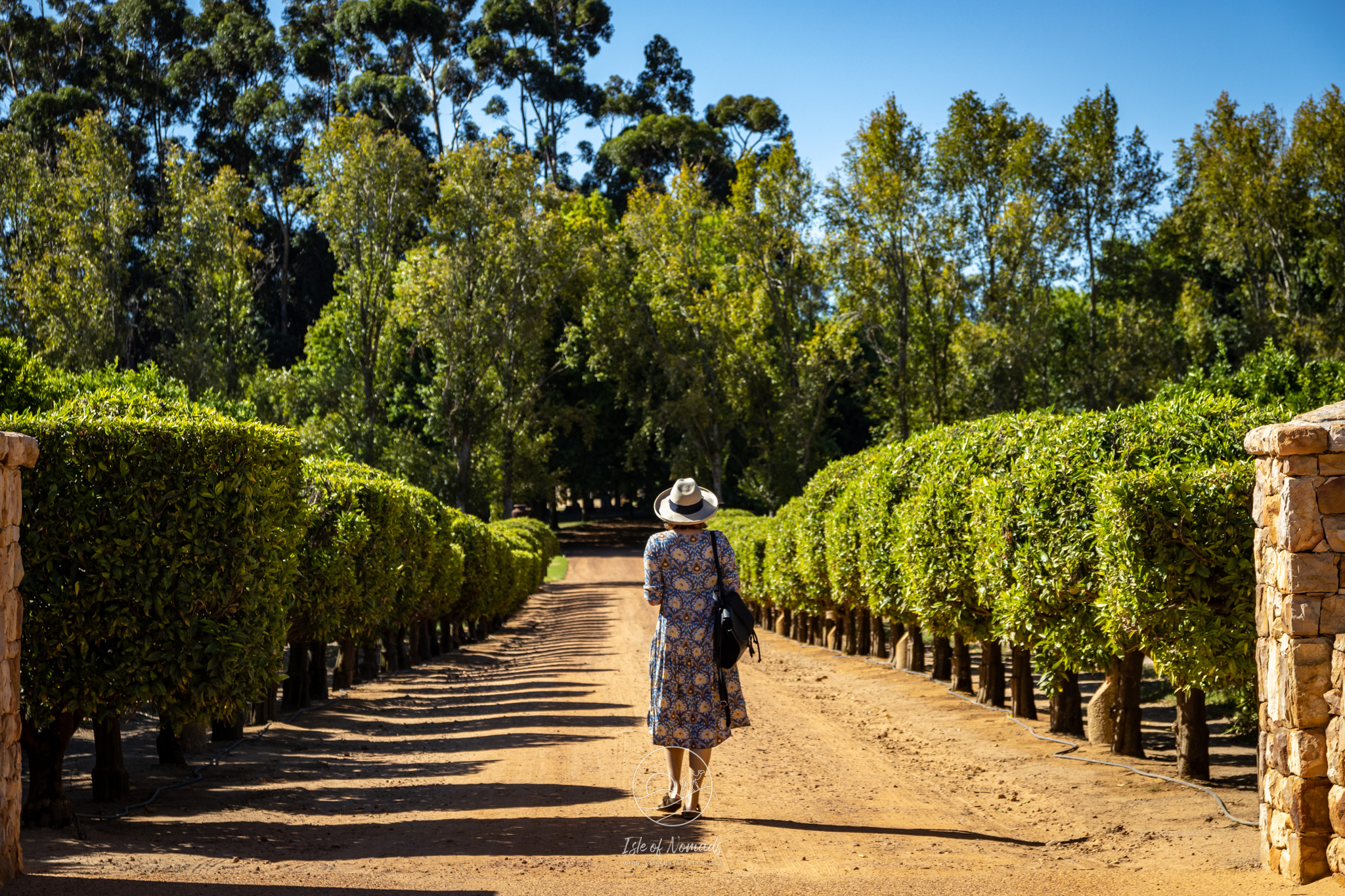
Day 7: Hermanus to Cape Aghulas
From Stellenbosch, drive to Hermanus. If you feel like it, you can take the longer route along the shores of False Bay via Pringle Bay for the beautiful views.
If you're visiting during the whale watching season (June to End November), make sure you book a boat or canoe trip to get out on the water. However, you'll likely also see many whales from the shore as they come incredibly close during the season! The Hermanus Cliff Path is a great place to spot them from the shore. If you're into horse riding, Heaven and Earth Trails organises nice rides through their beautiful farm land.
Continue driving to Cape Aghulas, visit the Southern Tip of Africa in the afternoon and then spend the night somewhere in the region.
Where to stay in Cape Aghulas:
- Both Top Deck and South of Africa are lovely, affordable self-catering options.
- For a mid-range budget, C-Pampoentjie is a great choice in Struisbaai just a few minutes east of Cape Aghulas
2-Week itinerary: Week 2
Day 8: To Wilderness
The next day, make your way to Wilderness via Swellendam. Swellendam is a cute town that makes for a nice stop-over to grab some coffee or lunch. On your way, also stop in Mossel Bay to wander around the Cape St Blaize Lighthouse Complex. If you have a bit of time on your way to Wilderness and are traveling on a clear day, you could do a detour via the Outeniqua Pass Lookout Point - it offers gorgeous views of the mountains along the coast.
In Wilderness, enjoy a stroll along the beach, and consider getting a surfing lesson at Vibe Surf School. The Map of Africa is a fun small detour from the village. Spend the night in Wilderness.
My recommendations for where to stay:
- Affordable: Wilderness Ocean View Cottage, RiverView and Equleni Guest Farm are not only affordable, but also beautiful places to stay!
- Mid range: Pearl Moon Boutique Suites and Swartvlei Guest Farm are both great options. Whispering Oaks Guest House is not in Wilderness but in George, but I still want to mention it as we loved staying in the colonial-style house and really appreciated the swimming pool!
- Luxury: Both Beach Villa Wilderness and Escape to the Beach offer incredible views, a luxurious surrounding and excellent service.

Day 9: To Plettenberg Bay via Knysna
On day 9, continue driving along the coast and make a stop in Knysna. Gericke's Point is a nice place for a hike to start the day.
In Knysna, make sure you don't miss Knysna Heads - the views are truly stunning as you watch the surf roll into the bay from above. If you want to spend some time at the beach, Brenton Beach is a beautiful place to go to and just chill in the sun for a bit.
Continue driving along the coast, until you've reached my favourite place along the Garden Route: Plettenberg Bay!
Day 10, 11 and 12: Plettenberg Bay
Three days in Plettenberg Bay is exactly enough so you can get a taste of the area and will want to come back for more. Spend one day in Plettenberg itself: Book a tour to go swimming with seals in the morning, and then head to Robberg Nature Reserve in the afternoon. I recommend you allocate 2-3 hours to walk the Witsand Circuit in Robberg. Then make your way back to Plettenberg in time to watch the sunset on Lookout Beach.

Spend your second day in the Tsitsikamma National Park. You can go on one of the many hikes, but do not miss the one across the suspension bridge to the Stormsriver Viewpoint. The last time we were there we also went on a Kayak Adventure with Untouched Adventures for the first time and it was a fun way to experience more of the National Park.
One day in Plettenberg should be dedicated to the many thrilling outdoor adventures you can join here. You can go abseiling (that's what we did, highly recommended!), Bungee Jumping (personally this is a tad too adventurous for me), surfing, or horseback riding. If all of this is too daunting for your, you could visit the Birds of Eden or the Lawnwood Snake Sanctuary.
If you really love hiking and have more than 2 weeks for this itinerary, you can check out the multi-day [Otter Trail] (https://www.alltrails.com/trail/south-africa/eastern-cape/otter-trail). It winds along the coast and I've heard it's well worth your time. Depending on your speed, it takes 2-3 days to complete.
Head to our Travel Guide for tips of where to stay and where to eat in Plettenberg, Knysna and Wilderness!


Day 13: Back to Oudtshoorn
On day 13 of your journey, drive back towards Cape Town via Oudtshoorn. Spend the day in Oudtshoorn: You can visit the Kango caves, head to an Ostrich farm and drive towards (or even across) the Swartberg Pass. If you are using a normal car, the road there is only driveable in good weather - consider checking with the locals in Oudtshoorn, they usually have good knowledge of the condition of the road.
Day 14: To Cape Town
Drive back to Cape Town and take your flight out. Mez Karoo makes for a great stop-over for lunch, but make sure to make reservations!
3-Week itinerary
Looking for recommendations on where to stay and eat? Have a look at our Travel Guide!
Day 1-13
Follow the 2-week itinerary above until Day 12.
On Day 13, instead of driving back towards Cape Town, continue along the coast. Take the whole day to make your way to Addo Elephant Park (ca. 370km with the detours listed here). On the way there, Cape St Francis and hiking the Wildside trail is a worthwhile stop-over. If you're really into surfing, stop (and maybe consider spending a few days) in Jeffreys Bay - this is a world-renowned surf spot that regularly hosts internatinal competitions.
In the evening, make your way to your accommodation somewhere close to Addo Elephant Park.

Day 14 and 15
Spend two days visiting Addo Elephant Park. I would suggest you take one day to explore on your own - you can self-drive in almost all parts of the park and do not need a 4x4 to do so. I love this way of going on my own pace and trying to spot animals from our car! Bring some packed lunch to enjoy while gazing at the beautiful elephants.
One morning (or whole day), you should also join a guided game drive - the guides are incredibly experienced and you'll definitely see more animals than if you set our by yourself. Also, they usually share fascinating facts about the animals you see.
Day 16
Drive the 90min to either Kenton on Sea or Port Alfred. Both are cute little towns known for their beaches and tranquility - stay for one day and explore the coast, go on a horse riding trip or take a surfing lesson.


Day 17
You then have to make a decision: Either continue up the coast to Durban, return your car there and fly out from Durban, or drive back to Cape Town to return your car and then fly out. I would recommend you drive back to Cape Town, but that is my personal preference: I do not particularly like Durban as a city and it's still quite a drive away from Kenton on Sea. Hence, this itinerary continues with the option of driving back to Cape Town, but here's a quick run-down of what I'd recommend if you want to continue to Durban: Stop over in Chintsa for a day, then do a driving day (~8h) all the way up to Durban. Spend two days in Durban and then fly out.
If you want to drive back to Cape Town, use Day 17 to drive from Kenton on Sea back to Prince Albert.
Day 18
Take one day to enjoy the quaint town of Prince Albert. You can attempt to drive the Swartberg Pass if you are a confident driver. Usually it's advised to go with a 4x4, but people have done it in Sedans. The views are gorgeous, so if you're feeling adventurous and it hasn't rained in a while (meaning the streets will hopefully be good), you could give it a go. If in doubt, check with the locals in Prince Albert about the condition of the road.
Take a hike in the Groot Swartberg Nature Reserve and stop by Fernskloof Wines.


Day 19
Drive the ~400km to and into the Cederberg Mountains. You could base yourself in Clanwilliam, or directly in the mountains, e.g. at Mount Ceder Lodge.
Day 20
While in the Cederberg Mountains, do at least one hike. If you're feeling fit, you could do a day hike to the Wolfberg Arch. Be wary of the weather though! It can get incredibly hot in the Cederberg mountains, which would make this hike even harder than it already is.
You could also take a dip in Maalgat Rock Pool and visit the Stadsaal Caves. The paintings in the caves are among the oldest in the world: They depict human figures and elephants and are believed to be up to 8000 years old!
Day 21
Make your way back to Cape Town, return your car and fly out.
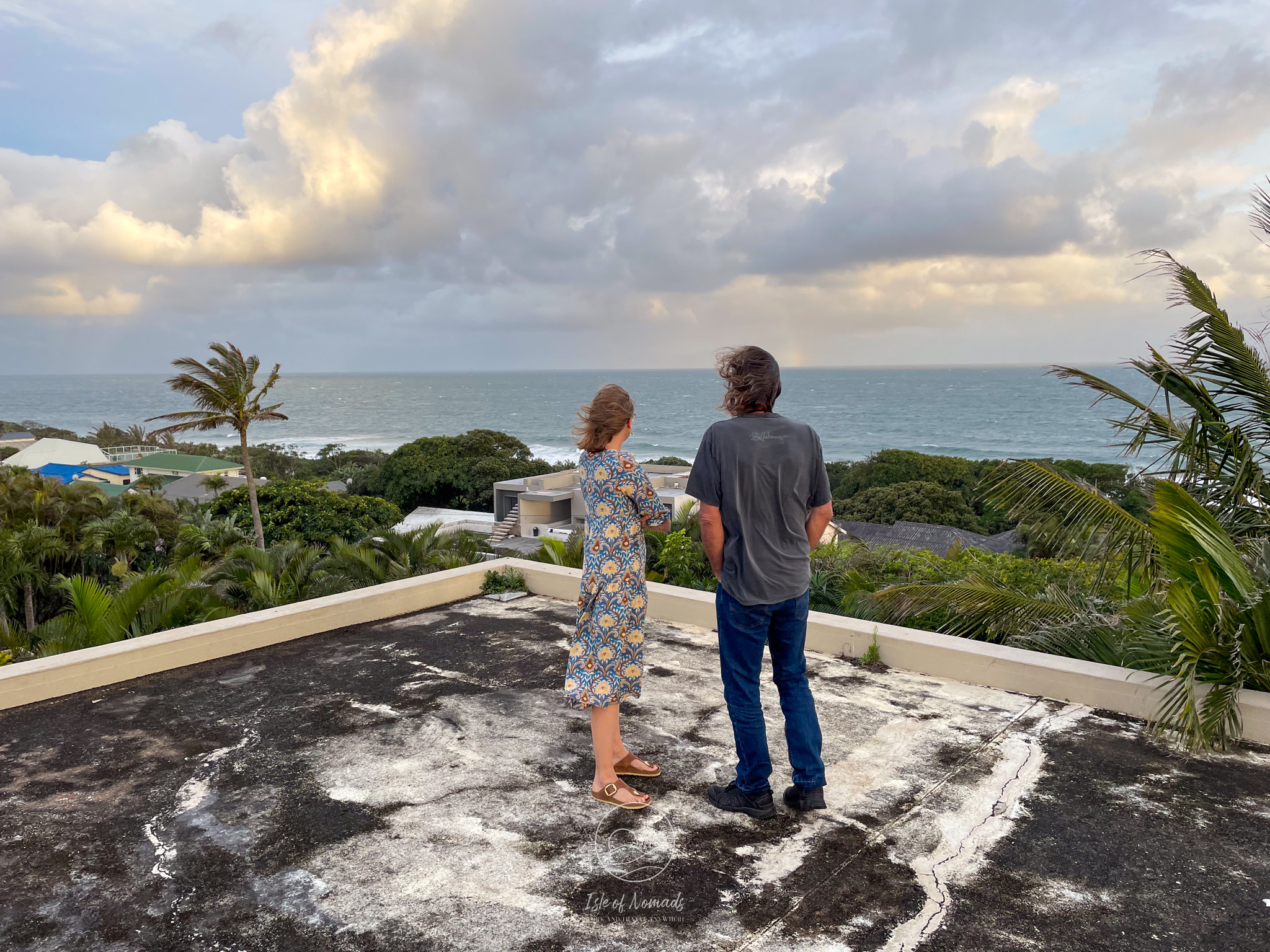
4-Week itinerary
Day 1 - 17
Follow the itinerary above until Day 17, and then go with the option of continuing towards Durban. Drive the 2.5 hours from Kenton on Sea to Chintsa and spend the remainder of the day there. Chintsa is part of the so-called "Wild Coast" of South Africa and when you are there, you'll understand why! The surf is incredibly strong and it's fascinating to just walk along the beach and marvel at the nature.
Day 18
A long driving day is ahead of you! It takes around 8 hours (630km) to drive from Chintsa to Durban.
Day 19
Spend one day in Durban - if you are here during whale watching season (May through to November), make sure to include a boat tour. Especially if you haven't done so in Hermanus already! Otherwise check out the beaches, head for a surfing lesson or just enjoy strolling around the city.
Day 20
It takes around 2.5 hours to drive to Drakensberg from Durban. I'd recommend to base yourself somewhere around Cathkin Park for best access to all the trails.
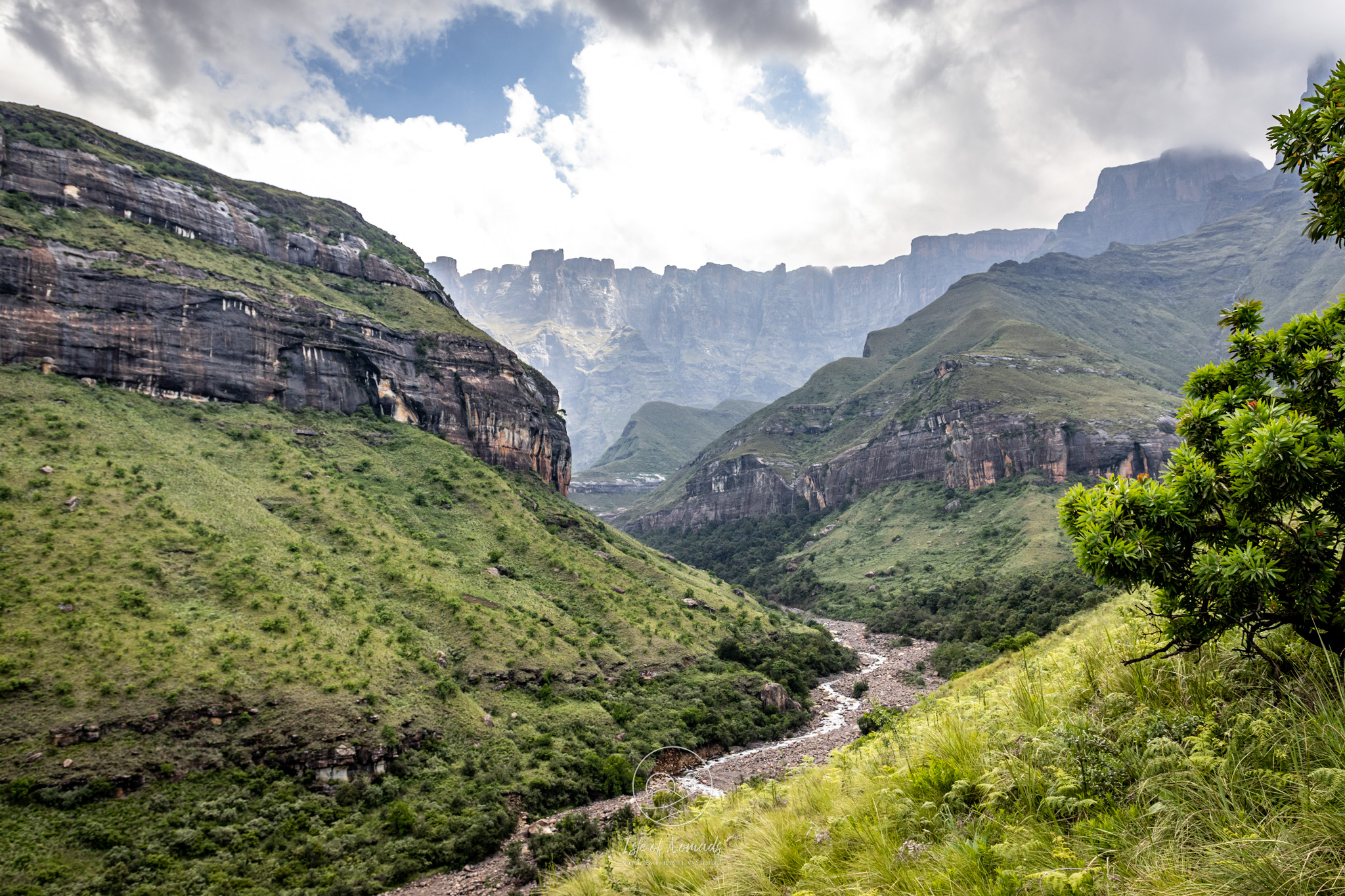
Day 21 and 22
Dedicate at least two days to exploring the majestic Drakensberg mountains on foot. The area offers so many activities that you could easily fill a week without running out of things to do. If your schedule allows, we highly recommend extending your stay — this is one of the South African destinations that Cordt and I are eager to revisit. (Partly because our previous trip was hampered by unfavorable weather, limiting our hiking opportunities).
For inspiration on hiking routes, check out AllTrails. Among the most renowned trails are the Tugela Falls hike (reputedly quite challenging!) and the trek to Cathedral Peak.
The region also offers exciting alternatives to hiking, such as a Canopy Tour and a visit to the Bird of Prey Center. For your stay, we suggest the Goodland Cottages.
Day 23 and 24
The journey from the Drakensberg to Johannesburg takes around 4.5 hours (400km). Spend one full day in Johannesburg: Explore the Apartheid Museum, consider going on a tour of Soweto, join a walking tour of downtown Johannesburg and visit the Cradle of Humankind.
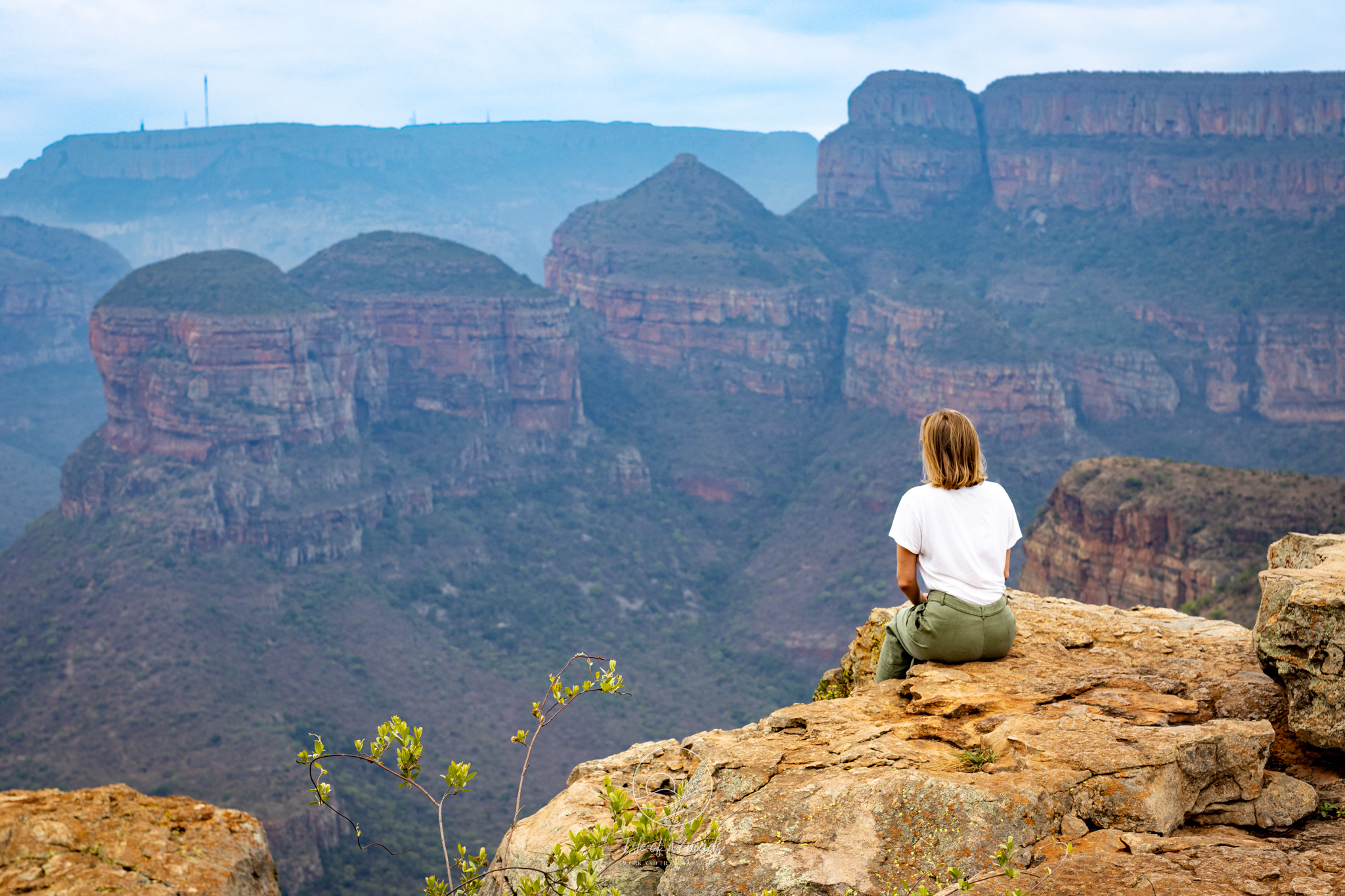
Day 25
Drive the ~6 hours from Johannesburg to the area around Kruger National Park. To maximize your experience in the region, I recommend you stay somewhere between Bushbuckridge and Hoedspruit as your base.
Day 26 and 27
Allocate two whole days to exploring the Kruger National Park and its surroundings: Dedicate two days to discovering the Park through self-drive safaris or organized drives. The park is easily navigable for standard vehicles, but its vast size and multiple entry points can be overwhelming. For a comprehensive overview of the park and its attractions, check the Kruger NP website. If you're feeling fatigued from driving or want expert assistance in wildlife spotting, you should join a guided game drive.
Reserve one day for the stunning Blyde River Canyon. Begin your day early with a boat tour on the Blyde River Dam. Afterward, embark on a 1h20min drive to reach the Three Rondavels View Point. For hiking enthusiasts, a 7km loop trail offers spectacular canyon vistas. From the viewpoints, continue your journey for another 20 minutes until you arrive at Bourke's Luck Potholes. During our visit, Cordt and I extended our route to Graskop for a circular drive, but in hindsight, the views beyond the potholes, including God's Window, didn't justify the extra distance in our opinio.
Day 28
Make your way back to Pretoria or Johannesburg, return your car and fly out.

5-Week itinerary
If you have an additonal 7 days, I would recommend you extend your stay in Drakensberg mountains by 1-2 days to allow for more activities and hikes. Also, consider adding 2 days in Lesotho to your trip. One or two additional days in the region around Kruger NP would also make for a more relaxed trip.
If you love hiking and mountains, you could add the Cederberg mountains and the stops I described above (Day 19 and 20 of the 3 week itineray) to your trip. From Cape Town, drive first to Clanwilliam to spend time in the Cederberg mountains, and then continue with the wine region as described above.
Try our Wine app
We recently finished the first version of a passion side-project that helps people discover vineyards in the Cape region — based on things like your wine preferences, whether you’re going solo or with friends, if you want to have lunch with your tasting, and even the weather.
If you love the winelands and enjoy trying out new tools, we’d love your help! We’re looking for a few people to test it out and tell us what you think — what works, what doesn’t, and what you'd love to see added. No catch, just something we built for fun and want to improve.
🚨 It’s iOS only for now.
💰 This is free of course - we are looking for feedback on something we built.
📩 If you're keen to test it, just drop us an email (info[at]zermin.de) and we’ll add you to the beta list.

